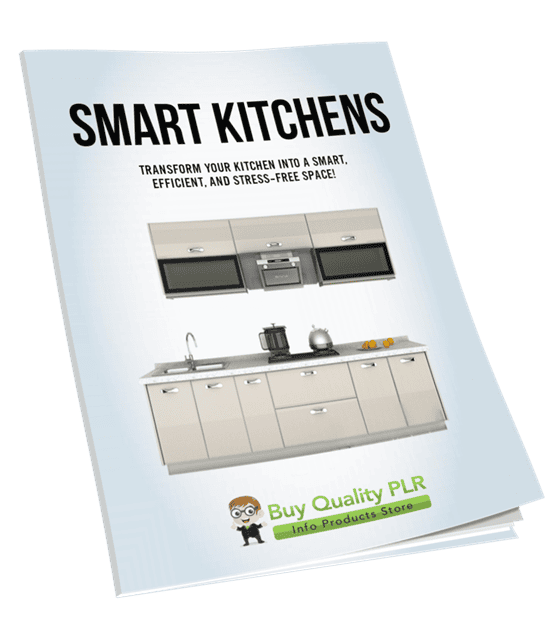
Smart Kitchens PLR Course 23k Words
in Cooking PLR Ebooks , Home Improvement PLR , Home Improvement PLR Ebooks , Home Remodeling PLR , PLR eBooks , PLR eCourses , PLR List Building Reports , Premium PLR , Premium PLR eBooks , Premium PLR Reports , Premium White Label Brandable PLR Coaching Courses , Private Label Rights ProductsChoose Your Desired Option(s)
has been added to your cart!
have been added to your cart!
#smartkitchen #hometech #kitcheninnovation #plrcontent #plrcourse #smarthome #cookingtrends
Smart Kitchens PLR Course – The Ultimate Guide to a High-Tech & Efficient Cooking Space
Transform Your Kitchen Into a Smart, Efficient, and Stress-Free Space!
The modern kitchen is no longer just a place to cook—it’s a hub of convenience, technology, and innovation. Smart kitchens combine high-tech appliances, automation, and organization systems to save time, reduce waste, and create a safer, more enjoyable cooking environment.
The Smart Kitchens PLR Course is a comprehensive step-by-step training program that walks you through everything you need to know about designing, managing, and maximizing a high-tech kitchen. With this course, you can educate your audience, sell premium content, or create a full training program that helps homeowners, cooking enthusiasts, and tech lovers upgrade their kitchen experience.
Presenting…
Smart Kitchens PLR Course 23k Words
Why a Smart Kitchen Matters
A smart kitchen isn’t just a luxury—it’s a practical solution to modern living. Here’s why you need to embrace smart kitchen technology:
- Save Time – Automated appliances, voice commands, and connected devices handle routine tasks, giving you more time for family, work, or relaxation.
- Reduce Waste – Smart fridges track ingredients, expiration dates, and even suggest meals based on what’s available. Smart scales help control portions and reduce food waste.
- Enhance Safety – Smart sensors prevent fires, gas leaks, and other hazards. You can monitor your appliances remotely for peace of mind.
- Boost Efficiency – Meal prep, shopping, cleaning, and inventory management become seamless with integrated apps and automated systems.
This course is perfect for anyone looking to educate themselves or others on the smart kitchen revolution, whether you are a blogger, course creator, home design consultant, or entrepreneur in the home and lifestyle niche.
What’s Included in the Smart Kitchens PLR Course
The course is structured into five comprehensive modules, each designed with easy-to-follow steps, actionable tips, and practical insights. You’ll also receive a checklist, FAQs, and a sales page ready for marketing.
Module 1: Understanding Smart Kitchens – The Basics
Before diving into gadgets and apps, it’s crucial to understand what makes a kitchen “smart” and how it can simplify everyday life.
Step 1: What Is a Smart Kitchen?
- Learn how technology integrates into cooking, cleaning, and storage.
- Understand automation tools, connected devices, and AI-powered appliances.
Step 2: The Benefits of a Smart Kitchen
- Save time and energy in meal prep and daily chores.
- Reduce food waste and monitor nutrition with intelligent appliances.
- Improve safety through smart sensors for fire, gas, and water leaks.
Step 3: Essential Features of a Smart Kitchen
- Smart appliances: fridges, ovens, dishwashers, coffee makers, and more.
- Voice control and automation using Amazon Alexa, Google Assistant, or Siri.
- Connected cooking with recipe apps that sync with appliances.
Step 4: Setting Goals for Your Smart Kitchen
- Define what you want: time savings, efficiency, energy conservation, or eco-friendliness.
- Create a personalized smart kitchen plan tailored to your lifestyle.
Module 2: Smart Appliances – Choosing the Right Technology
Smart appliances are the backbone of a modern kitchen. This module shows you how to choose, use, and integrate high-tech tools.
Step 1: Smart Refrigerators – Your Kitchen’s Brain
- Track groceries with built-in cameras and AI features.
- Receive expiration alerts and meal suggestions.
Step 2: Smart Ovens & Cooking Gadgets
- Preheat remotely and control settings with a smartphone or voice commands.
- Use precision sensors to ensure perfectly cooked meals every time.
Step 3: Smart Dishwashers & Cleaning Systems
- Auto-sensing dishwashers save water and energy.
- Smart trash bins and compost reminders reduce waste and clutter.
Step 4: Energy Efficiency & Cost Savings
- Track energy usage and optimize settings for savings.
- Smart appliances are designed to reduce utility costs over time.
Module 3: Smart Kitchen Organization & Storage Solutions
A cluttered kitchen can sabotage efficiency, even with the best technology. This module focuses on organization, storage, and workflow.
Step 1: Smart Pantry & Inventory Management
- Use apps to track ingredients, reorder items, and prevent spoilage.
- Label, categorize, and systematize storage for quick access.
Step 2: Space-Saving Hacks for Small Kitchens
- Install pull-out organizers, modular shelving, and stackable containers.
- Maximize counter space and maintain a clean, functional layout.
Step 3: Smart Shopping Lists & Meal Planning
- Sync lists with your smart fridge and online grocery platforms.
- Automate frequent orders and streamline meal prep.
Step 4: Decluttering & Going Minimalist
- Eliminate unused gadgets, expired food, and redundant appliances.
- Establish routines to maintain a minimalist, stress-free kitchen environment.
Module 4: Automating Your Kitchen for Maximum Efficiency
Automation is the key to a smart kitchen. Learn how to save time, reduce stress, and enjoy a seamless cooking experience.
Step 1: Voice-Controlled Cooking Assistants
- Control appliances, set timers, and follow recipes hands-free.
- Integrate Alexa, Google Home, or Siri into daily cooking tasks.
Step 2: Smart Coffee & Beverage Stations
- Program coffee makers or kettles for a perfect brew automatically.
- Schedule beverages to match your morning routine.
Step 3: Recipe Apps & Connected Cooking
- Use AI-powered apps like Tasty, Yummly, or Mealime to plan and cook.
- Sync your fridge and smart oven for guided, stress-free meal prep.
Step 4: Automating Cleaning & Maintenance
- Motion-sensor faucets save water, and robot vacuums maintain cleanliness.
- Schedule maintenance reminders for appliances and air quality monitors.
Module 5: Safety, Security & Sustainability in Smart Kitchens
A modern kitchen is not only efficient—it’s safe, secure, and eco-conscious.
Step 1: Smart Sensors & Safety Alerts
- Smoke detectors, gas leak sensors, and stove monitors alert you instantly.
- Reduce risks of accidents and enhance peace of mind.
Step 2: Smart Locks & Security Systems
- Monitor your kitchen remotely and control access.
- Protect appliances and valuables with smart locks and cameras.
Step 3: Sustainable & Eco-Friendly Practices
- Reduce food waste with inventory tracking.
- Use energy-efficient appliances and implement green cooking habits.
Step 4: Future-Proofing Your Smart Kitchen
- Keep software updated and invest in modular, upgradeable appliances.
- Ensure your kitchen adapts to new tech trends and innovations.
Final Thoughts & Next Steps
Congratulations! 🎉 You now have a solid roadmap to creating your smart kitchen.
- Start small—choose one or two smart appliances to integrate.
- Experiment with automation tools, apps, and workflow enhancements.
- Gradually expand your smart ecosystem to maximize efficiency, safety, and convenience.
Benefits you’ll enjoy:
- Less time spent cooking and cleaning
- Reduced food waste and improved meal planning
- Enhanced safety and peace of mind
- Streamlined kitchen operations for modern lifestyles
Upgrade your kitchen today and enjoy a high-tech, stress-free cooking space that improves your daily life!
Bonus Materials
- Smart Kitchens Checklist (793 words) – Step-by-step reference to keep your implementation on track.
- Smart Kitchens FAQs (947 words) – Answers to common questions and concerns.
- Smart Kitchens Salespage (705 words) – Ready-to-use copy for promotion and marketing.
How to Use & Profit from This PLR Course
With full PLR rights, you can:
- Sell as a Complete Course – Market to homeowners, kitchen designers, and cooking enthusiasts.
- Break into Mini-Reports ($10–$20 each) – Focus on individual modules like “Smart Appliances” or “Kitchen Organization.”
- Bundle With Other Home & Lifestyle PLR Products ($47–$97) – Create premium packages for higher profit margins.
- Create a Membership Site – Offer ongoing training, recipes, and smart kitchen tips.
- Convert to Multimedia – Audio guides, video tutorials, or eBooks for multiple platforms.
- Use as Lead Magnets – Grow your email list by offering valuable smart kitchen tips.
- Create Your Own Products – Launch coaching, consulting, or DIY kitchen makeover programs.
Licensing Terms
Permissions:
- Sell, edit, and repurpose freely
- Claim copyright if 75% of content is modified
- Use for digital courses, eBooks, and membership content
Restrictions:
- Cannot transfer PLR rights
- Max affiliate commission: 75%
- Cannot give the full course away for free
- Cannot bundle without additional purchase
Why You Need This Course
- Comprehensive & ready-to-use: 23,000+ words of detailed guidance
- Covers technology, appliances, organization, automation, and safety
- Fully PLR-ready for branding, selling, or repurposing
- Perfect for bloggers, course creators, and home improvement experts
- Enables creation of high-value, practical products in the smart home niche
Take Action Today
Invest in the Smart Kitchens PLR Course and start:
- Educating yourself or your clients on smart kitchen design
- Launching profitable courses, eBooks, or membership content
- Building authority in the home automation and lifestyle space
- Helping homeowners save time, stay safe, and enjoy cooking
Your smart, efficient, and modern kitchen journey starts here!
has been added to your cart!
have been added to your cart!
Here A Sample of Smart Kitchens PLR Course
Step-by-step training to transform your kitchen into a smart, efficient, and stress-free space!
Module 1: Understanding Smart Kitchens – The Basics
Before diving into gadgets and automation, let’s start with the foundation. What makes a kitchen “smart,” and how can it simplify your life?
Step 1: What is a Smart Kitchen?
Introduction to Smart Kitchens
A smart kitchen is a modern, technology-driven space designed to enhance efficiency, convenience, and automation in everyday cooking, cleaning, and storage. It integrates smart appliances, connected devices, and artificial intelligence (AI) to help individuals manage kitchen tasks with minimal effort and maximum precision.
Whether you are a busy professional, a home cook, or a restaurant owner, a smart kitchen can streamline processes, reduce energy consumption, and minimize waste, ultimately transforming the way you interact with your cooking space.
This step will guide you through the fundamental concepts of a smart kitchen, how it works, and why it is becoming an essential part of modern homes.
1. Defining a Smart Kitchen
A smart kitchen refers to a cooking space that incorporates automated devices, AI-powered systems, and internet-connected appliances to improve functionality and efficiency. It is designed to:
- Automate repetitive tasks such as preheating an oven, boiling water, or making coffee.
- Monitor food storage, alerting users about expiration dates and grocery needs.
- Enhance safety through gas leak detection, fire prevention, and remote monitoring.
- Optimize energy consumption by using energy-efficient appliances and smart sensors.
The goal of a smart kitchen is not just to introduce gadgets but to create a seamless, highly efficient, and user-friendly cooking experience that reduces time spent on manual tasks.
2. Core Elements of a Smart Kitchen
A smart kitchen is built on three essential pillars: automation, connectivity, and efficiency. Let’s explore each one in detail:
1. Automation: Hands-Free Assistance
Automation in a smart kitchen allows users to control appliances remotely, schedule tasks, and receive automated alerts. Examples include:
- Smart Coffee Makers: Program your machine to prepare coffee before you wake up.
- Voice-Controlled Assistants: Use Amazon Alexa, Google Assistant, or Apple Siri to set cooking timers, adjust temperatures, or find recipes.
- Automated Cooking Devices: Smart ovens can preheat automatically, detect the type of food inside, and suggest optimal cooking times.
Automation significantly reduces manual effort, making cooking and cleaning easier.
2. Connectivity: The Internet of Things (IoT) in Kitchens
The Internet of Things (IoT) connects smart appliances to your phone, tablet, or smart home hub, allowing you to control, monitor, and receive real-time updates. Key examples:
- Smart Refrigerators: Track groceries, send reminders for expiring food, and suggest meal plans.
- Smart Dishwashers: Detect load size, adjust water usage, and notify users when the cycle is complete.
- Smart Faucets: Automatically dispense the required amount of water, reducing waste.
With real-time connectivity, users can monitor their kitchen from anywhere, ensuring better organization and convenience.
3. Efficiency: Saving Time, Energy, and Resources
A smart kitchen helps save:
- Time: Automated appliances complete tasks quickly and efficiently.
- Energy: Smart devices optimize power consumption, reducing electricity bills.
- Food Waste: AI-powered meal planners and grocery trackers prevent overbuying and spoilage.
For example, motion-sensor lighting and energy-efficient smart stoves adjust power usage based on real-time activity, leading to a sustainable and cost-effective kitchen environment.
3. How a Smart Kitchen Works
To fully grasp the potential of a smart kitchen, let’s break down the process of how it works in a step-by-step approach:
Step 1: Integration of Smart Devices
The first step in creating a smart kitchen is installing smart appliances and devices that communicate with each other. Examples include:
- Smart Ovens that adjust temperatures automatically.
- AI-Powered Recipe Assistants that suggest meals based on available ingredients.
- Wi-Fi-Enabled Dishwashers that optimize cleaning cycles.
Step 2: Connectivity and Synchronization
Once devices are installed, they connect via Wi-Fi, Bluetooth, or smart home hubs, enabling:
- Remote control from a smartphone app.
- Synchronization with voice assistants for hands-free operation.
- Automated alerts for grocery tracking, cooking reminders, and cleaning schedules.
Step 3: User Input and Automation
Smart kitchens adapt to user behavior through:
- Voice commands for appliance control (e.g., “Preheat the oven to 180°C”).
- Machine learning-based recommendations (e.g., recipe suggestions based on past meals).
- Automated shopping lists and food inventory tracking.
Step 4: Smart Monitoring and Safety Features
A smart kitchen ensures security and efficiency with:
- Fire prevention sensors that automatically turn off burners.
- Smart locks on refrigerators and cabinets to prevent unauthorized access.
- Water leak detection systems that send alerts to avoid damage.
By following these four key steps, a smart kitchen transforms into a highly efficient, connected, and intelligent workspace.
4. Why a Smart Kitchen is the Future of Cooking
With the rise of AI-powered appliances, voice assistants, and automated systems, the future of cooking is becoming smarter and more efficient than ever before. Here are some key reasons why smart kitchens are gaining global popularity:
1. Saves Time and Effort
Smart appliances eliminate manual work, allowing users to focus on enjoying their meals rather than spending hours in the kitchen.
2. Reduces Energy Consumption
Smart stoves, refrigerators, and dishwashers use precise energy levels, cutting down on electricity and water usage.
3. Enhances Food Management
AI-powered systems track groceries, suggest recipes, and prevent food waste, promoting sustainable living.
4. Improves Safety and Security
Fire, gas, and water leak detectors ensure that the kitchen remains safe and hazard-free at all times.
5. Future-Proofing Homes
As technology evolves, a smart kitchen allows users to upgrade and integrate new features effortlessly, keeping their home modern and efficient.
Conclusion: Embracing the Smart Kitchen Revolution
A smart kitchen redefines traditional cooking and meal preparation by automating tasks, improving efficiency, and enhancing safety. Whether you are upgrading an existing kitchen or designing a new one, integrating smart technology can transform the way you cook, clean, and organize your space.
By understanding the foundations of a smart kitchen, you are now ready to explore advanced topics such as smart appliances, automation techniques, and kitchen optimization strategies.
In the next module, we will dive deeper into selecting the right smart appliances and how to maximize their benefits.
Key Takeaways
- A smart kitchen integrates technology, automation, and efficiency for a seamless cooking experience.
- IoT connectivity allows smart devices to communicate and synchronize for better convenience.
- Energy efficiency, time savings, and safety enhancements make smart kitchens a valuable investment.
- The future of kitchens is AI-driven, voice-controlled, and fully automated, providing users with more control and ease.
Stay tuned for the next lesson, where we explore how to choose the best smart appliances for your kitchen!
Step 2: The Benefits of a Smart Kitchen
A smart kitchen is not just about adding high-tech gadgets—it’s about creating a more efficient, sustainable, and safer cooking environment. By integrating smart appliances, artificial intelligence (AI), and the Internet of Things (IoT), a smart kitchen helps users save time, reduce waste, and improve safety.
In this step, we will explore the key benefits of a smart kitchen, breaking them down into actionable insights that demonstrate how technology transforms the way we cook, clean, and store food.
1. Save Time: Let Technology Do the Work While You Relax
One of the biggest advantages of a smart kitchen is time efficiency. Smart appliances can automate repetitive tasks, allowing users to focus on other priorities—whether it’s spending time with family, working, or simply relaxing.
How Smart Kitchens Save Time
1. Voice-Controlled and App-Operated Devices
- Smart ovens can preheat, set timers, and adjust temperatures using voice commands via Amazon Alexa, Google Assistant, or Apple Siri.
- Smart coffee makers can be programmed to brew coffee before you wake up.
- Smart microwaves detect food type and weight to automatically select the right cooking time.
2. Automated Cooking and Meal Preparation
- Smart slow cookers and multi-cookers allow users to set and forget their meals, adjusting heat and cooking time automatically.
- Smart blenders and juicers suggest recipes and adjust blending speeds based on the selected ingredients.
3. Grocery and Meal Planning Assistance
- Smart refrigerators can track inventory, suggest recipes based on available ingredients, and notify users when groceries are running low.
- Smart meal-planning apps integrate with smart kitchens, allowing users to schedule meals and automate grocery shopping lists.
Time-Saving Example
Imagine waking up to freshly brewed coffee, an oven preheated for breakfast, and an automatic reminder to use groceries before they expire—all without lifting a finger. That’s the power of a smart kitchen.
2. Reduce Waste: Smart Systems for Sustainable Living
Food waste is a major issue globally, but smart kitchens help users track, manage, and minimize waste by ensuring groceries are used efficiently.
How Smart Kitchens Reduce Waste
1. Smart Refrigerators for Inventory Management
- Track expiration dates and send alerts when food is about to go bad.
- Suggest recipes using ingredients that are nearing expiration.
- Scan barcodes or use AI image recognition to update grocery lists automatically.
2. Smart Scales for Portion Control
- Measure food accurately to prevent overuse of ingredients.
- Sync with health and fitness apps to ensure balanced meals.
- Reduce cooking waste by ensuring the right portion sizes.
3. Smart Composting and Recycling
- Smart composting bins track food waste and convert scraps into fertilizer.
- AI-driven waste management systems sort recyclable and non-recyclable materials.
Waste Reduction Example
A smart refrigerator alerts you that your vegetables will expire in two days and suggests a stir-fry recipe. Meanwhile, a smart scale ensures you use the right portions, and any leftovers go into a composting system that turns waste into fertilizer for home gardens.
3. Improve Safety: Smart Sensors Prevent Fires, Gas Leaks, and Other Hazards
Safety is a top priority in any kitchen. Smart technology helps monitor potential risks and prevent accidents before they happen.
How Smart Kitchens Improve Safety
1. Fire Prevention and Smoke Detection
- Smart stovetops and ovens automatically shut off if left unattended for too long.
- AI-driven smoke detectors send real-time alerts to smartphones.
- Heat-sensing cameras detect overheating and turn off appliances if necessary.
2. Gas Leak and Carbon Monoxide Detection
- Smart gas leak detectors monitor for leaks and alert users instantly.
- Some devices can automatically shut off gas valves to prevent explosions.
3. Water Leak and Overflow Prevention
- Smart dishwashers detect leaks and notify homeowners before damage occurs.
- Smart water sensors near sinks and pipes prevent floods and water waste.
4. Child Safety and Appliance Locks
- Smart refrigerators, ovens, and cabinets come with child-proof digital locks.
- Smart cutting boards and knives feature sensors to prevent accidental injuries.
Safety Example
You accidentally leave the stove on while rushing out the door. A smart sensor detects overheating, turns off the stove automatically, and sends you an alert. Meanwhile, your smart smoke detector ensures no fire hazard occurs, keeping your home and family safe.
Conclusion: Why Every Kitchen Should Be Smart
A smart kitchen is more than a high-tech luxury—it’s a practical solution for modern, efficient, and safe living.
Key Takeaways
✔ Save Time: Automate cooking, meal prep, and kitchen tasks with smart appliances.
✔ Reduce Waste: Use smart refrigerators, portion control, and composting systems to minimize food waste.
✔ Improve Safety: Prevent fires, gas leaks, and water damage with advanced sensors.
Next Step: Designing Your Smart Kitchen
Now that you understand the benefits of a smart kitchen, the next module will guide you on choosing the right smart appliances and setting up a fully automated kitchen.
With technology working for you, cooking can be safer, more efficient, and more enjoyable than ever before.
Step 3: Essential Features of a Smart Kitchen
A smart kitchen is more than just a place to cook—it’s an intelligent space that integrates technology to make meal preparation, storage, and cleaning more efficient. To create a fully functional smart kitchen, you need to incorporate smart appliances, voice control, and connected cooking solutions that work together to automate and simplify tasks.
In this step, we will explore the core features of a smart kitchen, breaking them down into easy-to-follow explanations that will help you understand their benefits and practical applications.
1. Smart Appliances: The Backbone of a Smart Kitchen
Smart appliances are Wi-Fi-enabled, AI-powered kitchen devices that allow users to control functions remotely via mobile apps or voice assistants. These appliances not only make kitchen tasks easier but also enhance efficiency, energy savings, and convenience.
Essential Smart Appliances
✔ Smart Refrigerators
- Track grocery inventory and notify you when items are running low.
- Suggest recipes based on available ingredients.
- Integrate with online grocery stores for automated shopping lists.
- Some models have transparent touchscreen doors that let you see inside without opening the fridge, helping to reduce energy waste.
✔ Smart Ovens & Microwaves
- Preheat and adjust temperature settings remotely via a mobile app.
- Use AI sensors to detect food type and adjust cooking time accordingly.
- Some ovens include built-in cameras to monitor food as it cooks.
- Sync with recipe apps to auto-adjust temperature based on the selected dish.
✔ Smart Dishwashers
- Use AI to detect the level of dirtiness and adjust the wash cycle accordingly.
- Voice-controlled start and stop functions.
- Remote monitoring and scheduling through smartphone apps.
✔ Smart Coffee Makers
- Program coffee brewing schedules to ensure fresh coffee is ready when you wake up.
- Adjust coffee strength and temperature via a mobile app.
- Sync with smart assistants for voice-activated brewing.
Smart Appliance Example
Imagine waking up to an alert from your smart fridge reminding you that you’re out of milk. Meanwhile, your smart coffee maker has already started brewing your favorite espresso. This level of automation saves time and effort, making mornings stress-free.
2. Voice Control & Automation: Hands-Free Kitchen Management
Voice control is a game-changer in smart kitchens, allowing users to control appliances, set timers, and get cooking instructions hands-free. This feature is especially useful when your hands are full or messy while cooking.
Popular Voice Assistants for Smart Kitchens
✔ Amazon Alexa
✔ Google Assistant
✔ Apple Siri
How Voice Control Enhances Kitchen Efficiency
✔ Hands-Free Operation
- Control appliances with simple voice commands (e.g., “Alexa, preheat the oven to 180°C” or “Hey Google, start the dishwasher”).
✔ Smart Timer & Notifications
- Set cooking timers and get alerts without touching a phone or appliance.
✔ Real-Time Assistance
- Ask for step-by-step cooking instructions while you prepare meals.
- Convert units of measurement on the go (e.g., “Hey Siri, how many grams in a cup of flour?”).
✔ Integration with Smart Home Systems
- Sync the smart kitchen with other home automation features (e.g., turning on the lights when the oven starts cooking).
Voice Control Example
Picture yourself making pizza dough with sticky hands. Instead of touching your phone or oven, you say, “Alexa, set a 30-minute timer for dough rising.” Your smart kitchen responds instantly, making cooking effortless.
3. Connected Cooking: Syncing Recipe Apps with Smart Appliances
One of the most exciting aspects of a smart kitchen is connected cooking, where smart appliances sync with recipe apps to guide users through meals with minimal effort.
How Connected Cooking Works
✔ Recipe Apps & AI Cooking Assistants
- Apps like Yummly, Tasty, SideChef, and Cookpad provide smart recipe recommendations.
- AI-driven suggestions tailor meal plans based on dietary preferences and available ingredients.
✔ Syncing Recipes with Smart Appliances
- Once you select a recipe, the app can send cooking instructions directly to smart appliances.
- A smart oven can automatically adjust cooking temperatures and set timers based on the recipe.
✔ Smart Scales & Measuring Devices
- Smart kitchen scales sync with apps to ensure precise ingredient measurements.
- Some scales provide real-time nutritional information based on the ingredients used.
✔ Augmented Reality (AR) Cooking Assistance
- Some apps provide AR-guided step-by-step cooking instructions using smart displays or glasses.
- Smart projectors can display virtual recipe guides on kitchen counters.
Connected Cooking Example
You decide to cook lasagna. You select a recipe on a connected cooking app, and it automatically preheats your smart oven, adjusts temperature settings, and sets cooking timers—allowing you to focus on assembling the dish rather than worrying about technical details.
Conclusion: The Future of Smart Kitchens is Here
By integrating smart appliances, voice control, and connected cooking, a smart kitchen transforms everyday meal preparation into an automated, efficient, and enjoyable experience.
Key Takeaways
✔ Smart Appliances: Improve convenience and efficiency with Wi-Fi-enabled fridges, ovens, dishwashers, and coffee makers.
✔ Voice Control & Automation: Use hands-free commands for cooking, timing, and managing kitchen tasks.
✔ Connected Cooking: Sync recipe apps with smart appliances for guided, hassle-free cooking.
Next Step: Setting Up Your Smart Kitchen
Now that you know the essential features of a smart kitchen, the next module will walk you through choosing the right appliances and setting up a fully integrated smart kitchen system.
With the right setup, your kitchen will not only be more efficient but also safer and more sustainable, making everyday cooking a seamless experience.
Step 4: Setting Goals for Your Smart Kitchen
Creating a smart kitchen is an exciting step toward a more efficient, automated, and sustainable home. However, before purchasing smart appliances or integrating new technologies, it’s essential to set clear goals based on your specific needs. A well-planned smart kitchen setup aligns with your lifestyle, budget, and priorities, ensuring that every feature adds value.
In this step, we will walk through a detailed process to define your smart kitchen goals, helping you make informed decisions that match your household’s unique requirements.
1. Identify Your Primary Goals: What Do You Want to Achieve?
A smart kitchen can serve multiple purposes, but the key is to prioritize the benefits that matter most to you. Before setting up your smart kitchen, ask yourself:
✔ Do you want to save time on cooking and cleaning?
✔ Are you looking to improve energy efficiency and lower utility bills?
✔ Is reducing food waste a priority for your household?
✔ Do you want hands-free, voice-controlled assistance for multitasking?
✔ Are you aiming for better meal planning and healthier eating habits?
Understanding your needs will help you select the right technology instead of getting overwhelmed by unnecessary gadgets.
2. Categorize Your Smart Kitchen Priorities
Once you’ve identified your goals, break them down into specific categories to customize your setup effectively.
A. Time-Saving Features: Automate and Simplify Cooking
If your main goal is to save time, focus on smart appliances and automation that reduce effort and speed up kitchen tasks.
✔ Smart Ovens & Microwaves – Preheat remotely, adjust temperature automatically, and sync with recipe apps for one-touch cooking.
✔ Smart Dishwashers – Set up remote start, scheduled washes, and AI-powered cycles that adjust based on load size.
✔ Smart Coffee Makers – Program brewing schedules, customize strength, and get your coffee ready as soon as you wake up.
✔ Voice-Controlled Assistants – Use hands-free commands to control appliances, set timers, and convert measurements instantly.
Example
If you’re a busy professional or a parent juggling multiple tasks, setting up voice-controlled kitchen commands with Google Assistant or Amazon Alexa can help streamline daily routines.
B. Energy Efficiency: Reduce Power & Water Usage
If your focus is on energy efficiency, invest in smart devices that minimize electricity and water consumption.
✔ Smart Refrigerators – Adjust cooling settings based on usage patterns to save electricity.
✔ Smart Ovens – Automatically switch off when cooking is complete to prevent wasted energy.
✔ Smart Dishwashers – Optimize water use and detect load size for eco-friendly cycles.
✔ Smart Plugs & Power Strips – Monitor and reduce energy consumption of non-smart appliances.
Example
If your electricity bills are high, integrating smart energy monitoring tools can help track real-time energy usage and suggest ways to cut costs.
C. Reducing Food Waste: Smarter Storage & Meal Planning
A smart kitchen can help minimize food waste through inventory tracking, portion control, and expiration date reminders.
✔ Smart Refrigerators – Keep track of expiration dates and suggest recipes based on available ingredients.
✔ Smart Scales & Measuring Devices – Ensure accurate portion sizes to reduce overuse of ingredients.
✔ AI-Powered Meal Planning Apps – Suggest meal ideas based on what’s in your fridge to prevent food spoilage.
Example
If you often find expired food in your fridge, investing in a smart fridge that sends reminders for expiring groceries can help reduce waste and save money.
D. Convenience & Multitasking: Hands-Free Kitchen Management
For those who love technology-driven convenience, a fully connected kitchen with voice control and remote monitoring is a game-changer.
✔ Voice-Activated Controls – Control appliances hands-free using Amazon Alexa, Google Assistant, or Apple Siri.
✔ Remote Monitoring – Use smartphone apps to check appliance status and receive alerts.
✔ Automated Shopping Lists – Sync grocery lists with smart fridges and pantry trackers.
Example
If you want to make cooking effortless, a smart recipe app that syncs with appliances can preheat the oven, adjust temperatures, and guide you through step-by-step cooking instructions.
3. Create a Personalized Smart Kitchen Plan
Once you’ve categorized your priorities, it’s time to create a structured plan for your smart kitchen transformation.
✔ Step 1: List Your Goals – Write down the top 3-5 priorities that align with your lifestyle.
✔ Step 2: Research Smart Appliances – Compare models and features to match your needs.
✔ Step 3: Budget & Plan Purchases – Determine how much you’re willing to invest in smart kitchen upgrades.
✔ Step 4: Integrate & Automate – Set up devices, connect them to apps, and explore automation options.
Example Personalized Plan
A working professional who wants to save time and reduce food waste may prioritize:
- Smart fridge with grocery tracking.
- Voice-controlled assistant for hands-free commands.
- Smart oven that syncs with a recipe app.
Meanwhile, a family-focused household might prioritize:
- Energy-efficient smart dishwasher to cut down on water usage.
- Automated meal planning app to organize family meals.
- Smart safety sensors to prevent stove or gas-related accidents.
4. Take Action: Start with One Smart Upgrade at a Time
Instead of overhauling your entire kitchen at once, start small and gradually integrate smart features based on your goals.
✔ Step 1: Upgrade One Appliance – Begin with the most essential smart device based on your priorities.
✔ Step 2: Learn & Adjust – Experiment with smart features and adjust settings for optimal use.
✔ Step 3: Expand Gradually – Once comfortable, add more smart integrations to enhance automation.
✔ Step 4: Monitor & Optimize – Use smart home apps to track efficiency, energy savings, and overall convenience.
Conclusion: Your Smart Kitchen, Your Way
Setting clear goals for your smart kitchen ensures that your technology choices align with your daily needs, lifestyle, and budget. Whether your focus is saving time, reducing energy consumption, minimizing food waste, or increasing convenience, your smart kitchen should be personalized for maximum efficiency.
Key Takeaways
✔ Define your smart kitchen goals: What do you want to improve?
✔ Prioritize features based on time-saving, energy efficiency, waste reduction, or convenience.
✔ Create a structured plan to guide your smart kitchen setup.
✔ Start small and gradually expand your smart kitchen based on your evolving needs.
Next Step: Smart Kitchen Safety & Maintenance
Now that you’ve set your goals, the next module will cover how to maintain and secure your smart kitchen, ensuring safe and efficient long-term use.
We’re also giving these extra bonuses
Smart Kitchens – Checklist

Smart Kitchens – FAQs

Smart Kitchens – Salespage Content

Package Details:
Word Count: 21354 Words
Number of Pages: 110
Smart Kitchens – Bonus Content
Checklist
Word Count: 793 words
FAQs
Word Count: 947 words
Salespage Content
Word Count: 705 words
Total Word Count: 23 799 Words
Your PLR License Terms
PERMISSIONS: What Can You Do With These Materials?
Sell the content basically as it is (with some minor tweaks to make it “yours”).
If you are going to claim copyright to anything created with this content, then you must substantially change at 75% of the content to distinguish yourself from other licensees.
Break up the content into small portions to sell as individual reports for $10-$20 each.
Bundle the content with other existing content to create larger products for $47-$97 each.
Setup your own membership site with the content and generate monthly residual payments!
Take the content and convert it into a multiple-week “eclass” that you charge $297-$497 to access!
Use the content to create a “physical” product that you sell for premium prices!
Convert it to audios, videos, membership site content and more.
Excerpt and / or edit portions of the content to give away for free as blog posts, reports, etc. to use as lead magnets, incentives and more!
Create your own original product from it, set it up at a site and “flip” the site for megabucks!
RESTRICTIONS: What Can’t You Do With These Materials?
To protect the value of these products, you may not pass on the rights to your customers. This means that your customers may not have PLR rights or reprint / resell rights passed on to them.
You may not pass on any kind of licensing (PLR, reprint / resell, etc.) to ANY offer created from ANY PORTION OF this content that would allow additional people to sell or give away any portion of the content contained in this package.
You may not offer 100% commission to affiliates selling your version / copy of this product. The maximum affiliate commission you may pay out for offers created that include parts of this content is 75%.
You are not permitted to give the complete materials away in their current state for free – they must be sold. They must be excerpted and / or edited to be given away, unless otherwise noted. Example: You ARE permitted to excerpt portions of content for blog posts, lead magnets, etc.
You may not add this content to any part of an existing customer order that would not require them to make an additional purchase. (IE You cannot add it to a package, membership site, etc. that customers have ALREADY paid for.)
Share Now!












